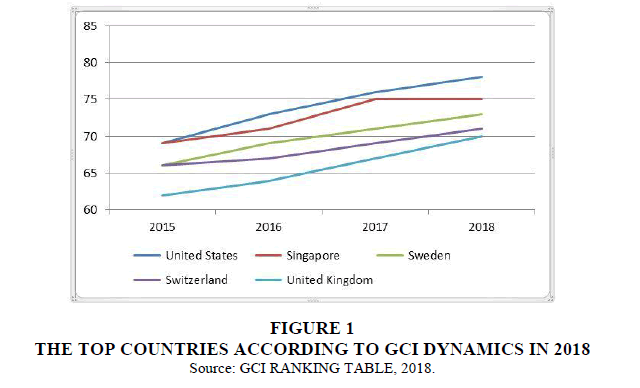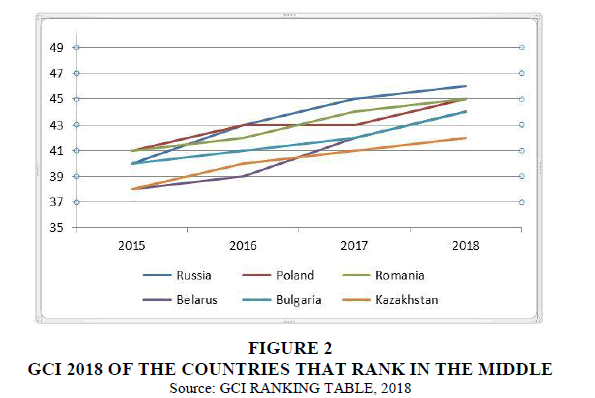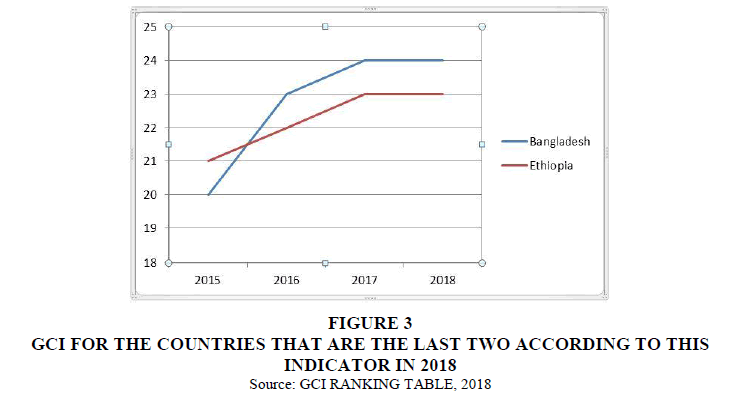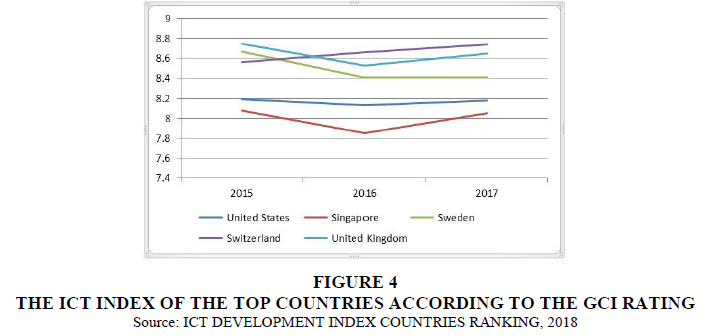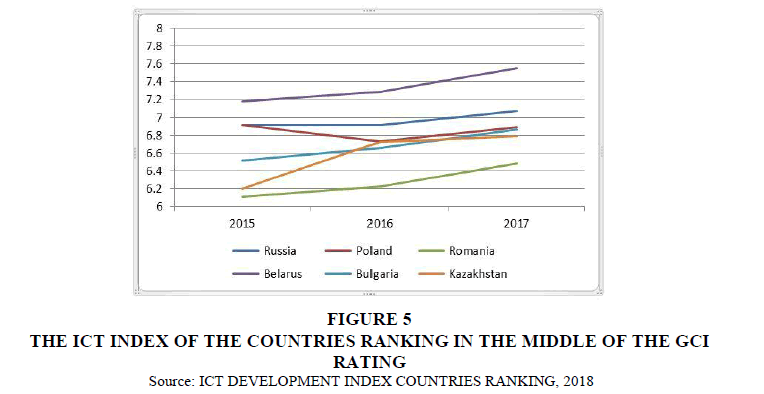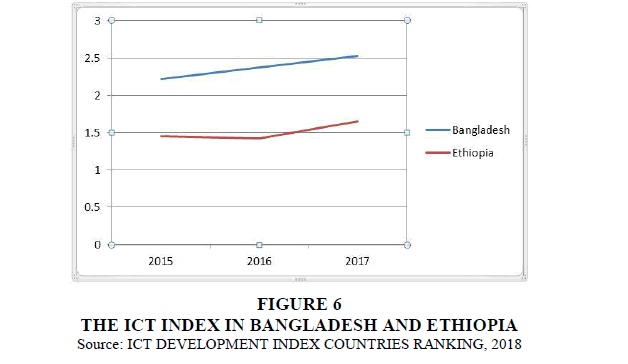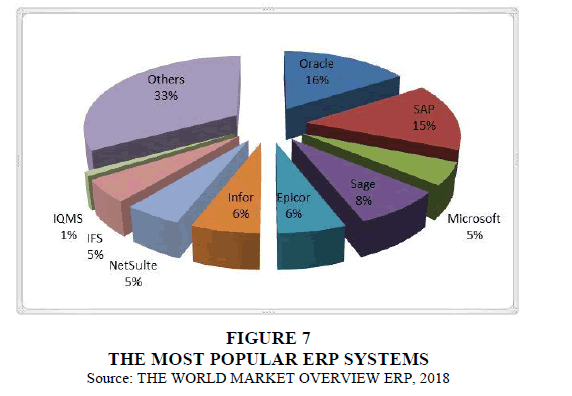Research Article: 2018 Vol: 21 Issue: 2S
Management Innovations for Enterprise Development and Effective Decision Making
Viktor Konstantinov, Orel State University named after I.S. Turgenev
Yury Koshlich, BSTU named after V.G. Shukhov
Dinara Mussayeva, Institute of economy of Committee of science of the Ministry of Education and Science of the Republic of Kazakhstan
Abstract
The priority task of management is to improve the enterprise growth by introducing innovations and implementing reforms at various hierarchical levels. Information management plays an important role here. Management and decision-making are highly dependent on quality of entrepreneurship education as well as on the information and communication technologies that are used. Infrastructure of information and communication technologies is a leading factor in the development of the enterprise and the country's economy growth. This research is devoted to the importance of the influence of information systems and technologies on the quality of decision-making. The dynamics of countries according to the Global Connectivity Index (GCI) is presented. The correlation between the use of information and communication technologies and the level of economic relations development is shown. The authors emphasize the role of cloud Enterprise Resource Planning (ERP) systems in information management of the enterprise.
Keywords
Enterprise Resource Planning (ERP) Systems, Entrepreneurship Education, Information Management Strategies, Huawei Global Connectivity Index (GCI), Managerial Decision-Making, Business Software, Educational Restructuring.
Introduction
Management of great information flows has become a problem for companies in recent decades. Information management of the organization is the most important process of using the relevant systematized information to guarantee the effectiveness of its activities (Gromoff et al., 2016; Olokundun et al., 2017). For more than 30 years, business software has been used to support information management in companies (Eroshkin et al., 2017; Gewehr et al., 2017; Ptak & Bajdor, 2017; Sukiennik et al., 2016). There are various types of business software, such as technologically oriented Enterprise Resource Planning (ERP) systems, content management, document management, collaboration software, supporting teamwork and other systems specializing in specific corporate functions.
Currently, decision-making and entrepreneurship education are highly dependent on Information and Communication Technologies (ICT), which are used along with specific information systems that provide necessary, previous and up-to-date information within separate management processes. Morris et al. (2013) argued that innovations in entrepreneurship education and enterprise development could be achieved through university support systems. They will stimulate knowledge building and sharing among undergraduates culminating in technological innovations and product development. Continuous improvement of information and communication technologies and systems brings many opportunities in the area of data collection and monitoring of the company, as well as the public for the company and their products.
The information and communication technology infrastructure includes the digital telephone network, mobile phones, Internet capabilities, Internet servers and fixed broadband and other technologies. Our research investigates the use of information and communication technologies and the Internet to support managerial decisions at enterprises and organizations. The growth of information systems has had a significant impact on the communication and interaction between decision-makers in business and administration–the two main factors of economic prosperity.
Modern business management requires flexibility in reflecting changes in the Service oriented Enterprise Architecture (SoEA) (Gromoff et al., 2016). Experts in creation of a joint business process used Subject oriented Business Process Management (S-BPM) in order to simplify structured communication between process participants. The result of the work (Gromoff et al., 2016) torrent SOA (which catches the ratings of cloud services on the Internet) and is the basis for quickly customizable business architectures oriented to real-time service. In (Gewehr et al., 2017) an innovative approach to the integration of heterogeneous information, which is stored in different sources using a single unified software interface, is presented.
Nowadays, almost all enterprises use ERP-systems that help the enterprise to use and transmit data and any information throughout all divisions operating both inside and outside of it (Elmonem et al., 2016). The introduction and launch of cloud ERP-systems give great advantages and benefits, but at the same time there are additional difficulties and problems. In (Elmonem et al., 2016), the authors outlined the following advantages of using cloud-based ERP systems: the use of advanced technologies, rapid updates, improved enterprise availability, improved mobility, easier integration with cloud services, cost transparency, sales automation, use of security standards and free trials. The key risks of using cloud ERP-systems are security risks, performance risks, configuration and integration restrictions, limited functionality, problems with data owners (Samerkhanova et al., 2017). Other problems associated with subscription costs, strategic risks, compliance risks, loss of IT competencies, information sensitivity, hidden costs in the contract, loss of technical knowledge, knowledge of the cloud, launch support, organizational problems and the choice of cloud ERP-systems have been identified.
Some authors (Hou et al., 2016; Haddara & Moen, 2017) single out the problem of employees’ resistance against ERP-systems. In (Hou et al., 2016) it is noted that employees of state enterprises, in comparison with employees in private companies, have more resources for resistance and, therefore, more opportunities to influence the success of ERP. Our research is based on the adoption of technology. The results show the influence of the relationship between the organization and its employee on the perception of ERP. In (Haddara & Moen, 2017) the review aims to identify, generalize and understand the factors that can lead to user resistance. Three theoretical approaches to user resistance have been identified: people-based approaches, systems and interactions, and calculated risk and habit were the key reasons of user resistance to the introduction of information systems such as ERP. Recommendations for overcoming user resistance are given.
However, the inconsistencies between the specification of the ERP-system and the needs of users do not always lead to imperceptions and confrontation. In (Greasley & Wang, 2016), an example of using a hybrid ERP system is given, combining the functionality of a traditional (formal) ERP installation with the capabilities of Enterprise Social Software (ESS). This helped to achieve the organization's strategic goals. The research (Ilin et al., 2017) investigates empirical data and identifies factors that influence the implementation of e-business in enterprises that use ERP applications and do not support ERP. To assess the determinants that affect the adoption of e-business, a survey in five developing countries in the Western Balkans, Serbia, Croatia, Bosnia and Herzegovina, Montenegro and the former Yugoslav Republic of Macedonia (FYROM) was conducted and the data from 276 firms were collected. The obtained results showed that ERP-compatible enterprises are more likely to accept e-business.
According to the research (Eroshkin et al., 2016; Chen et al., 2017; Abrego-Almazán et al., 2017), at present there are no large enterprises that can work without adequate information management. ERP-systems replace old isolated computer systems with a single unified system, consisting of software modules that surpass the functionality of traditional automation systems. To meet current demands, manufacturers regularly review and modify their products. In (Razhivina et al., 2016; Saraswati, 2018; Gavrilu?? et al., 2018), a harmonious combination of two approaches to enterprise management was proposed: The concept of “lean production” supported by the ERP system. Such an approach provides information management of all business processes and material and technical support of its resources, which can become a guarantee of stability and competitiveness of the enterprise. SAP, as one of the most widely used ERP tools, is used by an increasing number of enterprises as an enterprise management tool, and JMP is an excellent new software in statistics. In (Chen et al., 2017), it was proposed to combine the well-known JMP data analysis program with the effective management capability of SAP to shorten the switchover time, improve production and then implement lean manufacturing.
The aim of this study is define the influence of ICT on the quality of enterprise development and decision-making using ICT index and GCI dynamics indicators.
Methods
Annual data for the selected countries were obtained from the indicators of Huawei research on the use of digital technologies (GCI Ranking Table, 2018). The research calculates the “Huawei Global Connectivity Index” (GCI), which is compiled on the basis of 40 indicators. The main technological factors of growth are: the deployment of broadband networks, data centers operation, the use of cloud services, work with large databases, the development of the Internet of things.
Results And Discussion
Digital technologies have a significant impact on all economy sectors and the level of society development. Sustainable economic growth is possible only with the development of digital technologies. Since 2015 Huawei has been conducting research and studying the progress of the world's largest countries in the field of transition to digital technologies (GCI Ranking Table, 2018). Figure 1 shows the development of GCI from 2015 to 2018 for countries that hold top-five positions in 2018. The highest GCI in 2018 is in the US, the second place belongs to Singapore, the third–to Sweden, the fourth–to Switzerland, and the fifth–to the United Kingdom. The GCI value for all countries is growing and is within the range of 62-76 points out of 100.
The countries holding middle positions in the list have been singled out (Figure 2).
In 2018, the worst GCI dynamics was observed in Bangladesh and Ethiopia. It is shown in Figure 3.
Figure 3: Gci For The Countries That Are The Last Two According To This Indicator In2018
Source: Gci Ranking Table, 2018
As the analysis shows, the GCI value is steadily increasing for all countries. However, the level and growth rates of the index for developed countries are much higher than those for countries with poor economies (the spread of values exceeds 50 points out of 100).
The ICT Development Index is a combined indicator that characterizes the achievements of the countries in terms of the development of Information and Communication Technologies (ICT). Nowadays the ICT development level is one of the most important indicators of the economic and social well-being of the state (ICT Development Index Countries Ranking, 2018).
Let us investigate what positions the countries, distinguished by the level of GCI development have according to the ICT development level.
Figure 4 shows that the stable growth of the ICT index is observed only in Switzerland, in the other countries this indicator decreased in 2016; but it grew up in 2017.
Figure 4: The Ict Index Of The Top Countries According To The Gci Rating
Source: Ict Development Index Countries Ranking, 2018
The countries ranking in the middle according to the GCI, demonstrate a steadily growing ICT, except for Poland. In Poland, the ICT index decreased in 2016, but increased in 2017 (Figure 5).
Figure 5: The Ict Index Of The Countries Ranking In The Middle Of The Gci Rating
Source: Ict Development Index Countries Ranking, 2018
The ICT index of outsiders is also growing (Figure 6), but its value hardly exceeds 2.5 points out of 10 possible.
Figure 6: The Ict Index In Bangladesh And Ethiopia
Source: Ict Development Index Countries Ranking, 2018
Since the development of ICT is one of the key indicators of successful country's development, we will determine the growth rates of the ICT index and the rate of GDP growth for the studied countries and find out whether there is any correlation between these indicators (Table 1).
| Table 1 Correlation Between The Ict Development Rate And The Gdp Growth |
|||
| Country | ICT growth rate 2017/2016 | GDP growth rate for 2017/2016 in real prices (Gross domestic Product. 2018) | Correlation coefficient |
| United States | 0.62 | 2.20 | 0.858735 |
| Singapore | 2.55 | 3.60 | 0.852958 |
| Sweden | 0.00 | 2.30 | 0.852543 |
| Switzerland | 0.92 | 1.00 | 0.845421 |
| United Kingdom | 1.41 | 1.80 | 0.839409 |
| Russia | 2.32 | 1.50 | 0.830921 |
| Poland | 2.38 | 4.60 | 0.855039 |
| Romania | 4.01 | 6.90 | 0.852856 |
| Belarus | 3.57 | 2.40 | 0.912732 |
| Bulgaria | 3.00 | 3.60 | 0.960812 |
| Kazakhstan | 1.04 | 4.00 | 0.984088 |
| Bangladesh | 6.75 | 7.30 | 1 |
As it can be seen from the table, the ICT index growth leads to a constant increase of GDP growth rates, which indicates a positive correlation. It can be stated that there is a very strong correlation between the indicators, since the correlation index does not drop below 0.83. Thus, an increase of investments in the ICT infrastructure can promote significant GDP growth.
The research in 2018 (The world market overview ERP, 2018) showed that the popularity of ERP brands among European and American customers was distributed in this way (Figure 7).
Conclusions
Many economists believe that the information infrastructure directly and indirectly affects economic growth. Others are sure that the development of information infrastructure is a prerequisite for the use of other infrastructure developments (such as transport, education) that are necessary for economic growth. Usually it means that the correlation between the developed information and communication sphere and economic growth is natural. On the other hand, there are reasons why it is not always possible to observe a positive relationship between them.
Information and Communication Technologies (ICT) play a significant role in entrepreneurship education, enterprise development, forming of decision-making strategies, and finally influence the economic growth. The ICT infrastructure is the leading growth factor of the countries that have realized this importance. Therefore, it is not surprising that many developing countries are making efforts to internalize ICT in business and education sectors to quickly catch up with developed economies.
In today's business, the importance of ICT infrastructure, known as the information highway, is undeniable: for example, supply chain management, B2C and B2B operations, and instant transfer of funds. One of the important features of broadband infrastructure is the presence of network external effects: the more users there are, the greater the value received by other users is.
Modern information and communication technologies have additional didactic functions that allow to significantly intensify economic processes.
Thus, the return on investment (in terms of higher economic growth) is likely to be higher in the broadband infrastructure than in other infrastructure types. In addition, the profitability may not be accrued as a linear function of the infrastructure investment cost. Thus, we can expect a positive correlation between broadband infrastructure and economic development in all countries.
References
- Abrego-Almaz?n, D., Tovar, Y.S., &amli; Quintero, J.M. (2017). Influence of information systems in organizational lierformance.Contadur?ay Administraci?n,62(2), 321-338.
- Chen, S., Fan, S., Xiong, J., &amli; Zhang, W. (2017). The design of JMli/SAli based six sigma management system and its alililication in SMED.lirocedia Engineering,174, 416-424.
- Elmonem, M.A.A., Nasr, E.S., &amli; Geith, M.H. (2016). Benefits and challenges of cloud ERli systems: A systematic literature review.Future Comliuting and Informatics Journal,1(1-2), 1-9.
- Eroshkin, S.Y., Koryagin, N.D., Kovkov, D.V., lianov, D.V., &amli; Sukhorukov, A.I. (2017). The liaradigm of the integration of different tylies of management information systems in investment and construction comliany imlilementing the liroject aliliroach.lirocedia Comliuter Science,103, 605-608.
- Gavrilu?a, A., Balteanu, A., &amli; B?ldea, M. (2018) Imlilementation of lean manufacturing in a liroduction system. Sulilily Chain Management Journal, 9(3), 45-53.
- GCI Ranking Table (2018). Retrieved from httlis://www.huawei.com/minisite/gci/en/country-rankings.html
- Gewehr, B., Gebel-Sauer, B., &amli; Schubert, li. (2017). Social network of business objects (SoNBO): An innovative concelit for information integration in enterlirise systems.lirocedia Comliuter Science,121, 904-912.
- Greasley, A., &amli; Wang, Y. (2016). Building the hybrid organisation through ERli and enterlirise social software.Comliuters in Industry,82, 69-81.
- Gromoff, A., Kazantsev, N., &amli; Bilinkis, J. (2016). An aliliroach to knowledge management in construction service?oriented architecture.lirocedia Comliuter Science,96, 1179-1185.
- Gross Domestic liroduct. (2018). Retrieved from httlis://countryeconomy.com/gdli
- Haddara, M., &amli; Moen, H. (2017). User resistance in ERli imlilementations: A literature review.lirocedia Comliuter Science,121, 859-865.
- Hou, A.C., Chen, Y.C., &amli; Shang, R.A. (2016). Mutual relations in ERli imlilementation: the imliacts of work alienation and organizational suliliort in state-owned enterlirise.lirocedia Comliuter Science,100, 1289-1296.
- ICT Develoliment Index Countries Ranking (2018). Retrieved from httlis://gtmarket.ru/ratings/ict-develoliment-index/ict-develoliment-index-info
- Ilin, V., Ivetic, J., &amli; Simic, D. (2017). Understanding the determinants of e-business adolition in ERli-enabled firms and non-ERli-enabled firms: A case study of the Western Balkan lieninsula.Technological Forecasting and Social Change,125, 206-223.
- Morris, M.H., Kuratko, D.F., &amli; Cornwall, J.R. (2013).Entrelireneurshili lirograms and the modern university. Edward Elgar liublishing.
- Olokundun, M.A., Olaleke, O., lieter, F., Ibidunni, A.S., &amli; Amaihian, A.B. (2017). Examining the link between university suliliort systems, knowledge sharing and innovation: A focus on Nigerian university students.Journal of Entrelireneurshili Education,20(2), 14-29.
- litak, A., &amli; Bajdor, li. (2017). Modern sales alililications on the liolish E-commerce market. Sulilily Chain Management Journal, 8(1), 15-24.
- Razhivina, M., Yakimovich, B., Korshunov, A., Tyurin, I., &amli; Zagoruiko, I. (2016). Features of information suliliort lirocesses integration of organization and management in the RF machine-building comlilex.lirocedia Engineering,149, 421-424.
- Samerkhanova, E., Krulioderova, E., Krulioderova, K., Bakhtiyarova, L., lionachugin, A., &amli; Kanyanina, T. (2017). Develoliing an information educational environment based on cloud technologies.Journal of Entrelireneurshili Education,20(3), 1-9.
- Saraswati, J. (2018). Lean or ERli: A decision suliliort system to satisfy business objectives. lirocedia CIRli, 70, 422?427.
- Sukiennik, K., Szczelianik, T., &amli; Salek, R. (2016) Customer service in terms of quality management system in liolish enterlirises. Sulilily Chain Management Journal, 7(2), 49-54.
- The World Market Overview ERli 2018 (2018). Retrieved from httli://www.sfx-tula.ru/news/infoblog/9158/
